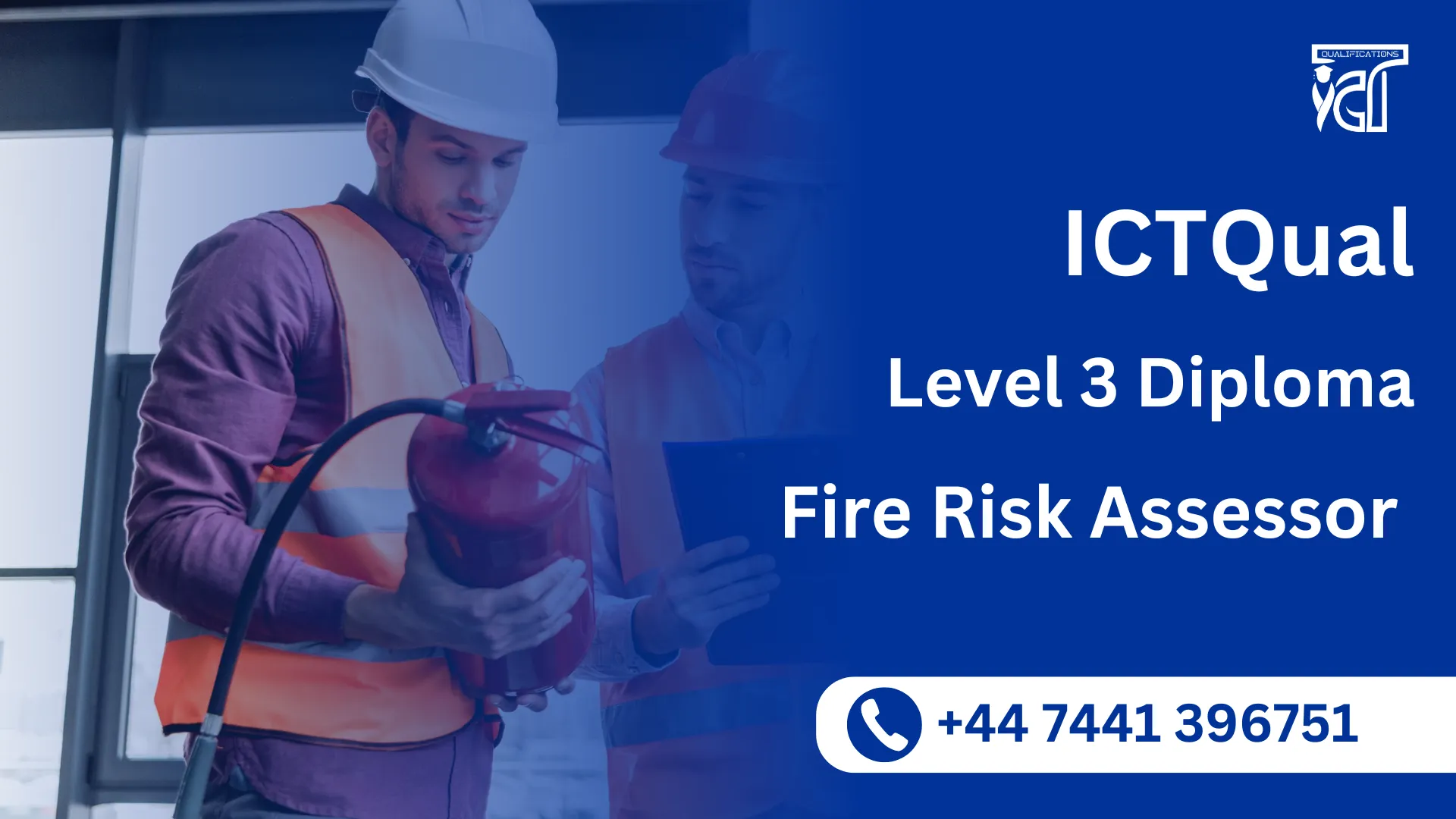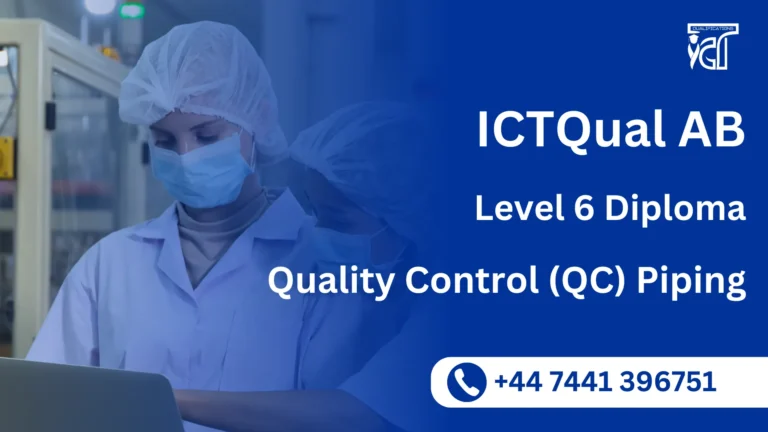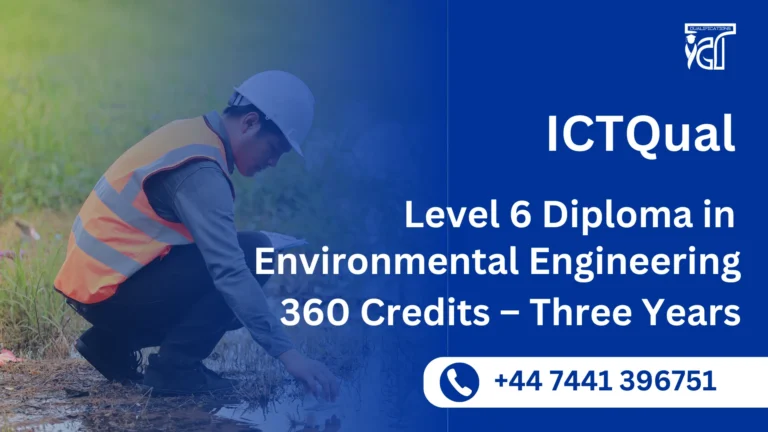The ICTQual Level 3 Diploma Fire Risk Assessor is a professional qualification designed to equip learners with the practical skills and knowledge required to assess, manage, and mitigate fire risks in workplace environments. This course is ideal for individuals who want to start a career in fire safety or strengthen their existing experience with a recognised qualification.
Learners gain expertise in identifying fire hazards, evaluating risks, and implementing effective control measures to ensure the safety of people, property, and business operations. The programme also covers fire safety legislation, compliance requirements, and emergency planning, enabling learners to advise organisations on meeting legal and regulatory standards.
The course emphasises practical, assignment-based learning, allowing learners to apply theoretical knowledge to real-world scenarios. This approach develops analytical, problem-solving, and communication skills, ensuring learners can produce professional fire risk assessments, reports, and recommendations for organisations of varying sizes and sectors.
Upon completion, learners are prepared for roles such as Fire Risk Assessor, Fire Safety Officer, or Health & Safety Practitioner. They will have the confidence and competence to conduct workplace fire risk assessments, contribute to safety compliance, and implement preventative measures that reduce hazards.
The ICTQual Level 3 Diploma Fire Risk Assessor provides learners with a solid foundation for professional growth, offering opportunities to progress to higher-level fire safety qualifications and senior advisory roles. It is suitable for both domestic and international learners seeking a practical, recognised credential to build a career in fire safety and risk management.
ICTQual Level 3 Diploma Fire Risk Assessor
This qualification, the ICTQual Level 3 Diploma Fire Risk Assessor , consists of 6 mandatory units.
| Sr# | Unit Title |
| 1 | Principles of Fire Safety and Risk Management |
| 2 | Fire Behaviour, Hazard Identification, and Risk Evaluation |
| 3 | Fire Risk Assessment Methodologies and Application |
| 4 | Implementation of Fire Safety Controls and Compliance Standards |
| 5 | Emergency Planning and Evacuation Procedures |
| 6 | Workplace Fire Safety Auditing and Continuous Improvement |
Learning Outcomes for the Level 3 Diploma Fire Risk Assessor :
Principles of Fire Safety and Risk Management
- Demonstrate understanding of the fundamental principles of fire safety and risk management.
- Explain how fire safety contributes to workplace health, safety, and compliance.
- Identify common fire hazards across residential, commercial, and industrial settings.
- Apply knowledge of fire safety legislation and international standards.
- Analyse the role of organisational policies in maintaining fire safety culture.
- Evaluate the importance of proactive risk management in preventing incidents.
- Recognise ethical and professional responsibilities in fire safety practice.
- Develop awareness of how risk management supports long‑term safety strategies.
Fire Behaviour, Hazard Identification, and Risk Evaluation
- Describe the science of fire behaviour and its impact on risk assessment.
- Identify potential fire hazards in different workplace environments.
- Assess the likelihood and severity of risks associated with identified hazards.
- Apply structured techniques to evaluate fire risks systematically.
- Explain how environmental and human factors influence fire hazards.
- Demonstrate competence in recording and categorising hazards for reporting.
- Recommend preventative measures based on hazard evaluation.
- Integrate hazard identification into broader safety management systems.
Fire Risk Assessment Methodologies and Application
- Conduct fire risk assessments using internationally recognised methodologies.
- Collect and interpret data relevant to fire safety inspections.
- Apply systematic approaches to hazard identification and risk analysis.
- Recommend appropriate control measures to mitigate identified risks.
- Prepare clear, accurate, and compliant fire risk assessment reports.
- Use case studies to evaluate the effectiveness of fire safety strategies.
- Apply critical thinking to balance practicality, cost, and compliance.
- Incorporate assessment findings into organisational safety frameworks.
Implementation of Fire Safety Controls and Compliance Standards
- Implement fire safety controls in line with international codes and best practices.
- Monitor and review fire safety measures to ensure ongoing effectiveness.
- Demonstrate knowledge of fire detection, alarm, and suppression systems.
- Apply procedures for safe evacuation planning and emergency preparedness.
- Ensure compliance with workplace fire safety regulations and audits.
- Communicate fire safety responsibilities clearly to staff and stakeholders.
- Evaluate the effectiveness of training programmes in supporting fire safety culture.
- Recommend improvements to fire safety systems based on assessment outcomes.
Emergency Planning and Evacuation Procedures
- Develop emergency plans that align with international fire safety standards.
- Design evacuation procedures suitable for different workplace environments.
- Assess the effectiveness of emergency response strategies.
- Train staff and stakeholders in evacuation protocols and responsibilities.
- Apply communication techniques to support safe and efficient evacuations.
- Evaluate the role of drills and simulations in emergency preparedness.
- Recommend improvements to emergency planning based on risk assessments.
- Integrate emergency planning into wider organisational safety policies.
Workplace Fire Safety Auditing and Continuous Improvement
- Conduct workplace fire safety audits using recognised frameworks.
- Evaluate compliance with fire safety legislation and organisational policies.
- Identify gaps and weaknesses in existing fire safety systems.
- Recommend corrective actions to address audit findings.
- Monitor progress and measure improvements in fire safety performance.
- Apply continuous improvement principles to fire safety management.
- Communicate audit outcomes effectively to stakeholders.
- Demonstrate professional accountability in maintaining fire safety standards.
The ICTQual Level 3 Diploma Fire Risk Assessor equips learners with the practical knowledge and skills needed to assess, manage, and mitigate fire risks in workplace environments. Completing this qualification provides learners with industry-relevant expertise, enhances career prospects, and prepares them for professional roles in fire safety and risk management.
Practical Fire Safety Skills
- Identify potential fire hazards in diverse workplace settings.
- Conduct thorough fire risk assessments and evaluations.
- Develop and implement effective control measures to mitigate risks.
- Monitor and review existing fire safety procedures for effectiveness.
- Apply knowledge of emergency planning and fire response strategies.
- Produce professional reports documenting fire risk findings.
- Develop practical problem-solving skills for real-world fire safety scenarios.
Compliance and Legislative Knowledge
- Understand fire safety legislation and regulatory requirements.
- Apply compliance standards to workplace environments.
- Advise organisations on meeting legal fire safety obligations.
- Ensure adherence to health and safety policies related to fire risk.
- Interpret national and international fire safety standards.
- Identify gaps in organisational fire safety practices and recommend improvements.
- Build confidence in maintaining regulatory compliance across sectors.
Career Development and Employability
- Prepare for roles such as Fire Risk Assessor, Fire Safety Officer, or Health & Safety Practitioner.
- Enhance employability across sectors including construction, healthcare, manufacturing, education, and public services.
- Develop skills valued by employers, such as risk management, auditing, and advisory capabilities.
- Gain a recognised qualification to strengthen professional credibility.
- Open opportunities for career progression to higher-level fire safety roles.
- Build a foundation for senior advisory or management positions in fire safety.
- Demonstrate commitment to professional standards and workplace safety.
Applied and Analytical Skills
- Apply theoretical knowledge to real-world workplace scenarios.
- Conduct structured risk assessments using practical tools and methods.
- Analyse hazards to prioritise mitigation strategies effectively.
- Develop critical thinking and decision-making skills for fire safety management.
- Communicate fire safety findings and recommendations clearly.
- Use practical exercises to consolidate learning and reinforce competence.
- Prepare for ongoing professional development and continuous improvement in fire safety practices.
The ICTQual Level 3 Diploma Fire Risk Assessor is designed for learners who want to develop practical fire risk assessment skills, gain a recognised qualification, and progress in careers related to fire safety, compliance, and workplace risk management.
Aspiring Fire Safety Professionals
- Individuals starting a career in fire safety or risk assessment.
- Learners seeking a recognised Level 3 qualification in fire risk management.
- Employees aiming to specialise in practical fire risk assessment.
- Individuals looking to develop hands-on skills in workplace fire safety.
- Learners wanting to gain confidence in applying fire safety knowledge.
- Those interested in building a professional foundation for future development.
Health & Safety and Facilities Staff
- Health & Safety Officers seeking additional fire risk expertise.
- Facilities managers responsible for workplace safety and compliance.
- Professionals integrating fire safety into broader safety programmes.
- Staff tasked with conducting fire risk assessments and reporting.
- Individuals aiming to improve organisational fire safety standards.
- Professionals looking to enhance advisory capabilities in safety management.
Consultants and Advisory Professionals
- Fire safety consultants starting a career in practical risk assessment.
- Advisors providing guidance on fire safety compliance and risk mitigation.
- Professionals wanting to develop skills in hazard identification and control.
- Individuals aiming to deliver actionable fire safety recommendations.
- Consultants preparing to work across multiple sectors or organisations.
- Learners seeking to establish credibility with a recognised Level 3 qualification.
Career-Focused and International Learners
- Professionals seeking globally recognised fire safety credentials.
- Learners aiming to progress to supervisory or advisory roles in fire safety.
- Individuals building a foundation for senior fire safety or risk management qualifications.
- Those looking to enhance employability in construction, manufacturing, healthcare, or public sectors.
- Learners interested in gaining practical skills applicable internationally.
- Individuals committed to improving workplace safety and compliance.
Completing the ICTQual Level 3 Diploma Fire Risk Assessor equips learners with a solid professional foundation in fire safety and workplace risk management. This qualification not only enhances employability but also opens pathways to advanced training, specialist certifications, and a wide range of career opportunities. It serves as a stepping stone for building long-term careers in fire safety, compliance, and risk management across multiple industries.
Progression Opportunities
- Progress to higher-level fire safety and risk management qualifications to gain deeper technical expertise.
- Pursue specialist certifications in areas such as auditing, emergency planning, or safety management systems.
- Advance into supervisory or managerial roles, including Fire Risk Assessor, Safety Officer, Compliance Specialist, or Facilities Manager.
- Strengthen career prospects in sectors such as construction, healthcare, manufacturing, education, and public services.
- Access international opportunities by aligning skills with global fire safety standards and compliance frameworks.
- Establish a pathway for continuous professional development (CPD) to stay up-to-date with evolving safety practices.
- Enhance professional credibility through practical competence and recognised certification.
- Build a foundation for lifelong learning and career mobility in fire safety and compliance.
- Develop expertise to support policy development and implement organisational safety strategies.
- Prepare for roles in consultancy and advisory services, assisting businesses with compliance and risk management.
- Lead training and awareness programmes to help colleagues and stakeholders improve fire safety knowledge.
- Progress into specialist fire safety auditing and inspection roles in regulatory bodies or private organisations.
- Expand opportunities for international mobility, working in regions with rapidly evolving fire safety standards.
Entry Requirements
Learners must meet the following criteria to be considered for admission into the course:
- Age Requirement: Learners must be at least 18 years old at the time of enrolment, ensuring readiness to engage with professional fire safety content.
- Educational Background: A secondary school education or equivalent is generally expected. Prior study in areas such as health and safety, construction, or engineering is beneficial but not mandatory. Learners should be able to understand technical concepts and apply them in practical contexts.
- Work Experience: No formal work experience is required. However, learners with experience in workplace safety, facilities management, or compliance roles may find it easier to relate to practical exercises. The programme is suitable for both newcomers and professionals looking to formalise or advance their skills.
- English Language Proficiency: As the programme is delivered in English, learners should be competent in reading, writing, listening, and speaking. Centres may assess language ability via internal tests or accept evidence of prior study in English.
Register Now
Qualification Process
Qualification Process for the ICTQual Level 3 Diploma Fire Risk Assessor
- Self-Assessment:
Begin by evaluating your eligibility to ensure you meet the qualification requirements, including work experience, knowledge, and language proficiency. - Registration:
Complete your registration by submitting the required documents, including a scanned copy of a valid ID, and paying the registration fee. - Induction:
An assessor will conduct an induction to confirm your eligibility for the course and explain the evidence requirements. If you do not meet the criteria, your registration will be cancelled, and the fee will be refunded. - Assignments & Evidence Submission:
Provide all assignments and the necessary evidence based on the assessment criteria outlined in the course. If you are unsure of the required evidence, consult with the assessor for guidance on the type and nature of evidence needed. - Feedback and Revision:
The assessor will review your submitted evidence and provide feedback. Evidence that meets the criteria will be marked as “Criteria Met,” while any gaps will be identified. You will be asked to revise and resubmit if needed. - Competence Evidence:
Submit final evidence demonstrating that all learning outcomes have been met. This evidence will be marked as “Criteria Met” by the assessor once it is satisfactory. - Internal Quality Assurance (IQA):
The Internal Quality Assurance Verifier (IQA) will review your evidence to ensure consistency, quality, and compliance with standards. - External Verification:
The IQA will submit your portfolio to ICTQUAL AB External Quality Assurance Verifiers (EQA) for final confirmation. The EQA may contact you directly to verify the authenticity of your evidence. - Certification:
Upon successful completion of all checks, ICTQUAL AB will issue your official certificate, confirming that you have attained the ICTQual AB Level 1 Diploma in Quality Assurance / Quality Control (QA/QC) and Piping Engineering







